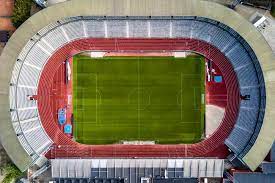Football Stadiums: The Heart of the Beautiful Game
Football, or soccer as it is known in some parts of the world, is undoubtedly one of the most popular sports on the planet. It has a global fan base that spans across continents and cultures. And at the heart of this beautiful game are the football stadiums, where fans come together to witness their favorite teams in action.
A football stadium is much more than just a venue for a match. It’s a place where emotions run high, where lifelong memories are created, and where history is made. From the roar of the crowd to the smell of freshly cut grass, there’s something special about being inside a football stadium.
The design of a football stadium plays an important role in creating an atmosphere that can inspire players and ignite passion in fans. The size and shape of the stands, the proximity to the pitch, and even the color scheme can all have an impact on how supporters feel during a game.
One of the most iconic football stadiums in history is Wembley Stadium in London. With its distinctive arch and capacity for 90,000 spectators, it has hosted some of the biggest matches in world football. From England’s historic World Cup victory in 1966 to UEFA Champions League finals and FA Cup finals, Wembley has seen it all.
But it’s not just about size and grandeur. Some smaller stadiums have become famous for their unique atmosphere and passionate fans. Borussia Dortmund’s Signal Iduna Park in Germany is one such example. Known as ‘The Yellow Wall’, its south stand holds over 25,000 supporters who create an incredible wall of noise during matches.
Of course, football stadiums aren’t just about what happens on match days. They’re also important community spaces that host events such as concerts, conferences and charity events throughout the year.
However, with great power comes great responsibility. Football stadiums have also been associated with hooliganism and violence in the past. In recent years, measures have been taken to improve safety and security, including CCTV cameras, stewards and police presence.
In conclusion, football stadiums are more than just bricks and mortar. They’re the beating heart of the beautiful game, where fans come together to celebrate their love for football. Whether it’s the grandeur of Wembley or the passion of The Yellow Wall, each stadium has its own unique character that makes it special.
Answers to Common Questions About Football Stadiums
- What is the name of football ground?
- Where are the biggest football stadiums?
- What is the biggest football stadium?
- What is biggest stadium in UK?
What is the name of football ground?
There are many football grounds around the world, each with their own unique names. Some of the most famous ones include Wembley Stadium in London, Old Trafford in Manchester, Camp Nou in Barcelona, and Maracanã Stadium in Rio de Janeiro.
Where are the biggest football stadiums?
The biggest football stadiums in the world are located in various countries and continents. Here are some of the largest football stadiums by capacity:
- Rungrado 1st of May Stadium, North Korea – Capacity: 150,000
- Michigan Stadium, USA – Capacity: 107,601
- Beaver Stadium, USA – Capacity: 106,572
- Ohio Stadium, USA – Capacity: 102,780
- Neyland Stadium, USA – Capacity: 102,455
- Sardar Patel Stadium, India – Capacity: 110,000 (under renovation)
- Camp Nou, Spain – Capacity: 99,354
- Azadi Stadium, Iran – Capacity: 95,225
- Wembley Stadium, England – Capacity: 90,000
- Bukit Jalil National Stadium, Malaysia – Capacity: 87,411
It’s worth noting that some of these stadiums may not be exclusively used for football matches and may also host other events such as concerts or political rallies. Additionally, some of these stadiums have undergone renovations or expansions in recent years which may have affected their overall capacity.
What is the biggest football stadium?
The biggest football stadium in the world, in terms of seating capacity, is the Rungrado 1st of May Stadium in Pyongyang, North Korea. It has a seating capacity of 114,000 spectators and is primarily used for football matches and national celebrations. The stadium was completed in 1989 and has hosted several international football matches, as well as mass games and other cultural events. However, it’s worth noting that due to the secretive nature of North Korea’s government, information about the stadium’s facilities and actual attendance figures can be difficult to verify.
What is biggest stadium in UK?
The biggest stadium in the UK is Wembley Stadium, located in London. It has a seating capacity of 90,000 spectators and is the home of the England national football team. The stadium has hosted many major sporting events, including the FA Cup final, League Cup final, and UEFA Champions League final. It is also used for concerts and other events throughout the year.
Tags: arch design, atmosphere, color scheme, crowd, emotions, fans, football, football stadium, football stadiums, global fan base, grass, history, iconic stadium, london, match, memories, pitch, players, soccer, sports, stands, venue, wembley stadium
